Selecting a Step-up (Boost) Converter
Step-up (Boost) Converters
Boost converters are used when VOUT needs to be higher than VIN.
Boost converters will step-up the input voltage to a higher output voltage. This is accomplished by charging an inductor via an internal MOSFET switch, and discharging the inductor via a rectifier to the load when the MOSFET switch is off.
The transition from inductor charge to discharge will reverse the voltage across the inductor, thereby stepping up the voltage higher than VIN. The on/off duty-cycle of the MOSFET switch will determine the VOUT/VIN boost ratio, and the feedback loop will control the duty-cycle to maintain stable output voltage. The output capacitor is the buffer element to reduce the output voltage ripple.
The current rating of the MOSFET switch together with step-up ratio will determine the maximum load current, and the MOSFET voltage rating will determine the maximum output voltage capability. In some boost converters, the rectifier is integrated as a MOSFET to provide synchronous rectification.
You might be interested in...
- Feature Product
- Parametric Search: Get your design started in no time!
